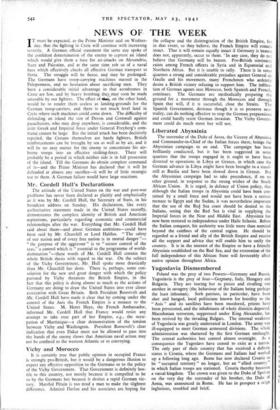Liberated Abyssinia
The surrender of the Duke of Aosta, the Viceroy of Abyssinia and Commander-in-Chief of the Italian forces there, brings the Abyssinian campaign to an end. The campaign has been brilliantly conducted, but it has been suggested in some quarters that the troops engaged in it ought to have been diverted to operations in Libya or Greece, in which case the German advance in Libya might have been brought to a stand- still at Bardia and have been slowed down in Greece. But the Abyssinian campaign had to take precedence, if on no other ground, in response to the strong wishes of the South African Union. It is urged, in defence of Union policy, that although the Italian troops in Abyssinia could have been con- tained by a small force and would not have been a serious menace to Egypt and the Sudan, it was nevertheless important that the use of the Red Sea coast should be denied to the Italians, seeing that the Red Sea is vital in supplying the Imperial forces in the Near and Middle East. Abyssinia has now been restored to independence under Haile Selassie. Before the Italian conquest, his authority was little more than nominal beyond the confines of the central region. He should be regarded as a friend and ally of the British Empire and receive all the support and advice that will enable him to unify the country. It is in the interest of the Empire to have a friendly Abyssinia established on the Red Sea, and the restoration of the full independence of this African State will favourably affect native opinion throughout Africa.






























 Previous page
Previous page